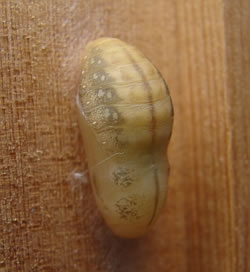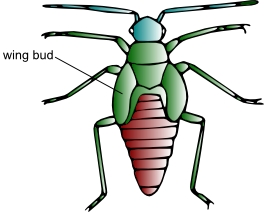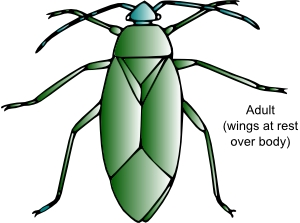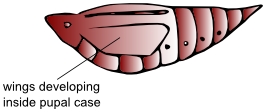Insect life cycles

The pupa of the Large Copper butterfly (Lycaena dispar). Butterflies undergo complete metamorphosis.
The main disadvantage of the exoskeleton is that it can't expand with growth. In order for growth to take place, the exoskeleton must be shed and a new one formed. The new one will be soft at first, so the body must be expanded before the new one hardens. The organism can then grow to fill the space created before moulting becomes necessary again.
The process of moulting is called ecdysis, and the stage between successive moults an instar. Once adulthood has been reached, growth ceases and the adult insect doesn't moult again. This means that the stages occurring before the adult are the ones in which growth occurs.
There are two different types of insect life cycle - incomplete metamorphosis and complete metamorphosis. (Metamorphosis means a change of form.)
- Incomplete Metamorphosis
This is shown by the less highly developed insects. The life cycle shows only three stages:-
EGG - NYMPH - ADULT
The nymph resembles a miniature adult but is not able to produce young. This life cycle has the disadvantage that both nymph and adult often share the same food source. Therefore they can be in direct competition with one another for food. The advantage is that the vulnerable pupal (chrysalis) phase is avoided. The wings develop during the nymph stages as wing buds. These grow larger at each successive instar. They are fully formed at the final moult into adulthood. The wings therefore develop outside the body and are said to be exopterygote. This type of life cycle is seen in various insects, including dragonflies, grasshoppers, earwigs, cockroaches and true bugs:-
Diagrams of Incomplete Metamorphosis of Capsid bug (instars two and four not shown)
First instar nymph

Third instar nymph

Adult

- Complete Metamorphosis
This is shown by the more highly developed insects. The life cycle shows four stages:-
EGG - LARVA - PUPA - ADULT
The larva (or caterpillar) is the growth phase. It is generally very different from the adult. Usually the larva and adult use different food sources. Therefore they are not in direct competition. This is a distinct advantage as more individuals of the species can be fed. The pupa (or chrysalis) is a stage of internal reorganisation. There are no visible signs on the outside of the body as to the activity within. Because of this the pupal phase used to be called the "resting" stage. During the pupal phase the internal organs are broken down, more or less forming a "soup". This "soup" then acts as food for special growth buds to develop. These form the adult body. When reorganisation is complete, the adult is ready to emerge. When outside conditions are suitable, the final moult occurs and the adult insect emerges. The wings develop inside the pupal case. Therefore this type of development is said to be endopterygote. Such a life cycle is shown by butterflies, moths, bees, wasps, true flies and many other insects, including beetles:-
Diagrams of Complete Metamorphosis of Large White butterfly (only one of the four caterpillar stages is shown)
Caterpillar

Pupa

Adult female butterfly

Previous: Mouthparts | Next: Overwintering
![Amateur Entomologists' Society home page [Logo]](/images/aes-logo-wplant.gif)